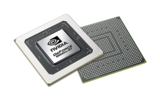NVIDIA GeForce 9800M GTS SLI

The Nvidia GeForce 9800M GTS SLI consists out of two GeForce 9800M GTS in SLI mode. Each 9800M GTS is based on the G94 core with 64 shader processors. The chips are produced in 65nm (512 MB) and later in 55nm (1024 MB versions). Therefore, the boards power consumption stays the same (75 Watt) for both versions.
The SLI version of the 9800M GTS is about 0-40% faster than a single 9800M GTS (depending on the SLI support of the game and the driver version). In some games there may even be a slight decrease of performance. Furthermore, some games may suffer from micro stuttering in the range of 30 fps (because of the different frametimes). This means you may need more fps for a fluent gameplay experience. Still DirectX 10 games should run in medium to high detail settings and resolutions.
As all cards with DirectX 10 capabilities, the GeForce 9800M GTS renders the 3D images using "Unified Shaders". There don't exist any more dedicated pixel- and vertex shaders but 2x64 so called stream processors make the graphic work (which has been done by pixel and vertex shaders in former days). Furthermore, the shader units are higher clocked than the chip (1500 MHz).
An advantage of the GeForce 9000 series is the integrated PureVideo HD video processor. It is able to help with the decoding of H.264-, VC-1-, MPEG2- and WMV9 video material in HD quality and eases the CPU.
In conjunction with the Nvidia 9100M G integrated graphics, the 9800M GTS supports Hybrid-SLI (only HybridPower). HybridPower is a technique to choose between the integrated and dedicated graphics core, if performance or battery runtime is needed. This works only in Windows Vista. Up to now the user has to use a tool to switch between the GPUs. Later Nvidia wants to switch automatically in the drivers. GeForceBoost is not supported with this card, as there would be no performance gain to combine the integrated GPU with the 9800M GTS.
Compared to desktop graphics cards, the 9800M GTS SLI should be a bit slower than the GeForce 8800 GS in SLI mode(which has a higher memory clock rate).
GeForce 9800M Series
| |||||||||||||||||||
| Codename | NB9E-GT | ||||||||||||||||||
| Architecture | G9x | ||||||||||||||||||
| Pipelines | 128 - unified | ||||||||||||||||||
| Core Speed | 600 MHz | ||||||||||||||||||
| Shader Speed | 1500 MHz | ||||||||||||||||||
| Memory Speed | 800 MHz | ||||||||||||||||||
| Memory Bus Width | 256 Bit | ||||||||||||||||||
| Memory Type | GDDR3 | ||||||||||||||||||
| Max. Amount of Memory | 512 MB | ||||||||||||||||||
| Shared Memory | no | ||||||||||||||||||
| API | DirectX 10, Shader 4.0 | ||||||||||||||||||
| Power Consumption | 150 Watt | ||||||||||||||||||
| Transistor Count | 1.5 Billion | ||||||||||||||||||
| technology | 55 nm | ||||||||||||||||||
| Features | PureVideo HD, CUDA, PhysX-ready, SLI | ||||||||||||||||||
| Notebook Size | large | ||||||||||||||||||
| Date of Announcement | 15.07.2008 | ||||||||||||||||||
| Information | 2xMXM 3 | ||||||||||||||||||
| Link to Manufacturer Page | www.nvidia.com | ||||||||||||||||||
Benchmarks
3DM Vant. Perf. total +
* Smaller numbers mean a higher performance
Game Benchmarks
The following benchmarks stem from our benchmarks of review laptops. The performance depends on the used graphics memory, clock rate, processor, system settings, drivers, and operating systems. So the results don't have to be representative for all laptops with this GPU. For detailed information on the benchmark results, click on the fps number.
| low | med. | high | ultra | QHD | 4K | |
|---|---|---|---|---|---|---|
| Crysis - GPU Benchmark | 44 | |||||
| Crysis - CPU Benchmark | 46 | |||||
| low | med. | high | ultra | QHD | 4K | < 30 fps < 60 fps < 120 fps ≥ 120 fps | | | 2 | | | |
For more games that might be playable and a list of all games and graphics cards visit our Gaming List
Notebook reviews with NVIDIA GeForce 9800M GTS SLI graphics card
Toshiba Qosmio X300-13W: Intel Core 2 Extreme QX9300, 17.00", 4.3 kg
External Review » Toshiba Qosmio X300-13W
Toshiba Qosmio X300-14O: Intel Core 2 Extreme QX9300, 17.00", 4.3 kg
External Review » Toshiba Qosmio X300-14O






